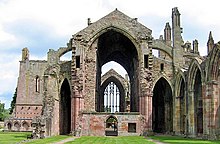Melrose, Scottish Borders: Difference between revisions
remove gaelic name, gaelic is not spoken in this area, might as well have the japanese name for the town! |
Undid revision 328712916 by 95.145.233.19 (talk) |
||
| Line 4: | Line 4: | ||
|country = Scotland |
|country = Scotland |
||
|official_name = Melrose |
|official_name = Melrose |
||
|gaelic_name = Am Maol-Ros |
|||
|scots_name = Melrose |
|scots_name = Melrose |
||
|map_type = Scotland |
|map_type = Scotland |
||
Revision as of 11:43, 1 December 2009
Melrose
| |
|---|---|
| Population | 1,671 (2001 census) |
| OS grid reference | NT540340 |
| Council area | |
| Lieutenancy area | |
| Country | Scotland |
| Sovereign state | United Kingdom |
| Post town | MELROSE |
| Postcode district | TD6 |
| Dialling code | 01896 |
| Police | Scotland |
| Fire | Scottish |
| Ambulance | Scottish |
| UK Parliament | |
| Scottish Parliament | |
Melrose is a small, historic town in the Scottish Borders, historically in Roxburghshire. It is in the Eildon committee area.
The town's name is recorded in its earliest form as Mailros, 'the bare peninsula' (Old Welsh or Brythonic), referring to the original site of the monastery, recorded by the Venerable Bede, in a bend of the river Tweed. The original monastery at Melrose is referred to in the Anglo-Saxon Chronicle with the name Magilros (at which time Melrose was part of Northumbria).
In the late Middle Ages, when the monastery had been re-founded in its present position, its name was symbolically represented by the visual pun of a mell (mason's hammer) and a rose (symbolising the Virgin Mary, to whom all Cistercian abbeys were dedicated).
Melrose is the location of Melrose Abbey, re-founded for the Cistercian order by David I in the early 12th century, one of the most beautiful monastic ruins in Great Britain. It is the site of the burial of the heart of Scottish king Robert the Bruce. An excavation was led to find a sealed casket, but it was not opened, and it was actually discovered by high school students involved in the dig. The casket was placed in a sealed lead cylinder, and was then re-buried in the abbey back at its proper resting place. The remains of the Abbey are cared for by Historic Scotland (open all year; entrance charge).
Nearby is the Roman fort of Trimontium, and Dryburgh Abbey. Melrose is surrounded by the small villages of Darnick, Gattonside, Newstead, and Bowden.
King Arthur is supposedly buried in the Eildon Hills, which overlook the town. A few miles west of the town lies Abbotsford House, the home of novelist Sir Walter Scott.
Melrose is the birthplace of Rugby Sevens and also has a rugby union team, Melrose RFC. Melrose is an area where rugby union has always been the most popular sport.
Melrose also has Melrose golf club which is a nine hole golf course situated on the edge of the town at the foot of the Eildon Hills.
Every year in June Melrose has a festival week known as the Melrose Festival. This involves appointing a Melrosian who has lived in the town for most of his life. The Melrosian for 2009 is Clark Eaton Turner. Also a queen and her court are appointed from the local primary school, Melrose Grammar School.
Property in Melrose is also 10% higher than the average in other Border towns mainly on its reputation.
Melrose is now host to the annual Borders Book Festival which also takes place during June. The 2005 festival hosted guests including Michael Palin and Germaine Greer; Ian Rankin and Rory Bremner appeared in 2006.



Notable people
- Catherine Helen Spence (31 October 1825 – 3 April 1910) ,Australian author, teacher, journalist, politician and leading suffragette was born in Melrose, and left for Australia when aged fourteen.
- Jim Telfer, noted rugby coach.
- Craig Chalmers, capped 60 times for Scotland.
- Keith Robertson (rugby union)
- Alexander Mitchell, teenage author.
